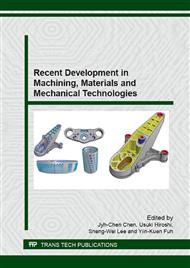[1]
L Bocquet, E Charlaix. Nanofluidics, from Bulk to Interfaces. Chemical Society Reviews, 39 (2010) 1073-1095.
Google Scholar
[2]
W Sparreboom, A van den Berg, J C T Eijkel. Principles and Applications of Nanofluidic Transport. Nature Nanotechnology, 4 (2009) 713-720.
DOI: 10.1038/nnano.2009.332
Google Scholar
[3]
B N Persson. Sliding Friction: Physical Principles and Applications. Springer, (2000).
Google Scholar
[4]
Y Zhu, S Granick. Limits of the Hydrodynamic No-Slip Boundary Condition. Physical Review Letters, 88 (2002) 106102.
DOI: 10.1103/physrevlett.88.106102
Google Scholar
[5]
R G Horn, J N Israelachvili. Direct Measurement of Structural Forces between Two Surfaces in a Nonpolar Liquid. The Journal of Chemical Physics, 75 (1981) 1400-1411.
DOI: 10.1063/1.442146
Google Scholar
[6]
S Granick. Motions and Relaxations of Confined Liquids. Science, 253 (1991) 1374-1379.
DOI: 10.1126/science.253.5026.1374
Google Scholar
[7]
J N Israelachvili, P M Mcguiggan, A M Homola. Dynamic Properties of Molecularly Thin Liquid Films. Science, 240 (1988) 189-191.
DOI: 10.1126/science.240.4849.189
Google Scholar
[8]
M L Gee, P M Mcguiggan, J N Israelachvili, et al. Liquid to Solid-Like Transitions of Molecularly Thin Films under Shear. The Journal of Chemical Physics, 93 (1990) 1895-(1906).
DOI: 10.1063/1.459067
Google Scholar
[9]
J Klein, E Kumacheva. Confinement-Induced Phase Transitions in Simple Liquids. Science, 269 (1995) 816-819.
DOI: 10.1126/science.269.5225.816
Google Scholar
[10]
J Klein, E Kumacheva. Simple Liquids Confined to Molecularly Thin Layers. I. Confinement-Induced Liquid-to-Solid Phase Transitions. The Journal of Chemical Physics, 108 (1998) 6996-7009.
DOI: 10.1063/1.476114
Google Scholar
[11]
E Kumacheva, J Klein. Simple Liquids Confined to Molecularly Thin Layers. Ii. Shear and Frictional Behavior of Solidified Films. The Journal of Chemical Physics, 108 (1998) 7010-7022.
DOI: 10.1063/1.476115
Google Scholar
[12]
A L Demirel, S Granick. Glasslike Transition of a Confined Simple Fluid. Physical Review Letters, 77 (1996) 2261-2264.
DOI: 10.1103/physrevlett.77.2261
Google Scholar
[13]
Y Zhu, S Granick. Reassessment of Solidification in Fluids Confined between Mica Sheets. Langmuir, 19 (2003) 8148-8151.
DOI: 10.1021/la035155+
Google Scholar
[14]
T-D Li, E Riedo. Nonlinear Viscoelastic Dynamics of Nanoconfined Wetting Liquids. Physical Review Letters, 100 (2008) 106102.
DOI: 10.1103/physrevlett.100.106102
Google Scholar
[15]
S Patil, G Matei, A Oral, et al. Solid or Liquid? Solidification of a Nanoconfined Liquid under Nonequilibrium Conditions. Langmuir, 22 (2006) 6485-6488.
DOI: 10.1021/la060504w
Google Scholar
[16]
F Mugele, M Salmeron. Dynamics of Layering Transitions in Confined Liquids. Physical Review Letters, 84 (2000) 5796-5799.
DOI: 10.1103/physrevlett.84.5796
Google Scholar
[17]
T Becker, F Mugele. Nanofluidics: Viscous Dissipation in Layered Liquid Films. Physical Review Letters, 91 (2003) 166104.
DOI: 10.1103/physrevlett.91.166104
Google Scholar
[18]
S de Beer, D van den Ende, F Mugele. Dissipation and Oscillatory Solvation Forces in Confined Liquids Studied by Small-Amplitude Atomic Force Spectroscopy. Nanotechnology, 21 (2010) 325703.
DOI: 10.1088/0957-4484/21/32/325703
Google Scholar
[19]
L Bureau. Nonlinear Rheology of a Nanoconfined Simple Fluid. Physical Review Letters, 104 (2010) 218302.
Google Scholar
[20]
G B Kaggwa, J I Kilpatrick, J E Sader, et al. Artifact-Free Dynamic Atomic Force Microscopy Reveals Monotonic Dissipation for a Simple Confined Liquid. Applied Physics Letters, 93 (2008) 011909-011903.
DOI: 10.1063/1.2950324
Google Scholar
[21]
S de Beer, D van den Ende, F Mugele. Confinement-Dependent Damping in a Layered Liquid. Journal of Physics: Condensed Matter, 23 (2011) 112206.
DOI: 10.1088/0953-8984/23/11/112206
Google Scholar
[22]
S de Beer, W K den Otter, D van den Ende, et al. Non-Monotonic Variation of Viscous Dissipation in Confined Liquid Films: A Reconciliation. EPL (Europhysics Letters), 97 (2012) 46001.
DOI: 10.1209/0295-5075/97/46001
Google Scholar
[23]
L Wan, C R Iacovella, T D Nguyen, et al. Confined Fluid and the Fluid-Solid Transition: Evidence from Absolute Free Energy Calculations. Physical Review B, 86 (2012) 214105.
DOI: 10.1103/physrevb.86.214105
Google Scholar
[24]
F Liu, S de Beer, D van den Ende, et al. Atomic Force Microscopy of Confined Liquids Using the Thermal Bending Fluctuations of the Cantilever. Physical Review E, 87 (2013) 062406.
DOI: 10.1103/physreve.87.062406
Google Scholar
[25]
A Maali, T Cohen-Bouhacina, G Couturier, et al. Oscillatory Dissipation of a Simple Confined Liquid. Physical Review Letters, 96 (2006) 086105.
DOI: 10.1103/physrevlett.96.086105
Google Scholar
[26]
S H Khan, E L Kramkowski, P J Ochs, et al. Viscosity of a Nanoconfined Liquid During Compression. Applied Physics Letters, 104 (2014) 023110.
DOI: 10.1063/1.4861856
Google Scholar
[27]
J P Gao, W D Luedtke, U Landman. Layering Transitions and Dynamics of Confined Liquid Films. Physical Review Letters, 79 (1997) 705-708.
DOI: 10.1103/physrevlett.79.705
Google Scholar
[28]
H Docherty, P T Cummings. Direct Evidence for Fluid-Solid Transition of Nanoconfined Fluids. Soft Matter, 6 (2010) 1640-1643.
DOI: 10.1039/c000821d
Google Scholar
[29]
H Matsubara, F Pichierri, K Kurihara. Mechanism of Diffusion Slowdown in Confined Liquids. Physical Review Letters, 109 (2012) 197801.
DOI: 10.1103/physrevlett.109.197801
Google Scholar
[30]
H Matsubara, F Pichierri, K Kurihara. Unraveling the Properties of Octamethylcyclotetrasiloxane under Nanoscale Confinement: Atomistic View of the Liquidlike State from Molecular Dynamics Simulation. The Journal of Chemical Physics, 134 (2011).
DOI: 10.1063/1.3530591
Google Scholar
[31]
J Israelachvili, Y Min, M Akbulut, et al. Recent Advances in the Surface Forces Apparatus (SFA) Technique. Reports on Progress in Physics, 73 (2010) 1-16.
DOI: 10.1088/0034-4885/73/3/036601
Google Scholar
[32]
J N Israelachvili, N A Alcantar, N Maeda, et al. Preparing Contamination-Free Mica Substrates for Surface Characterization, Force Measurements, and Imaging. Langmuir, 20 (2004) 3616-3622.
DOI: 10.1021/la0352974
Google Scholar


